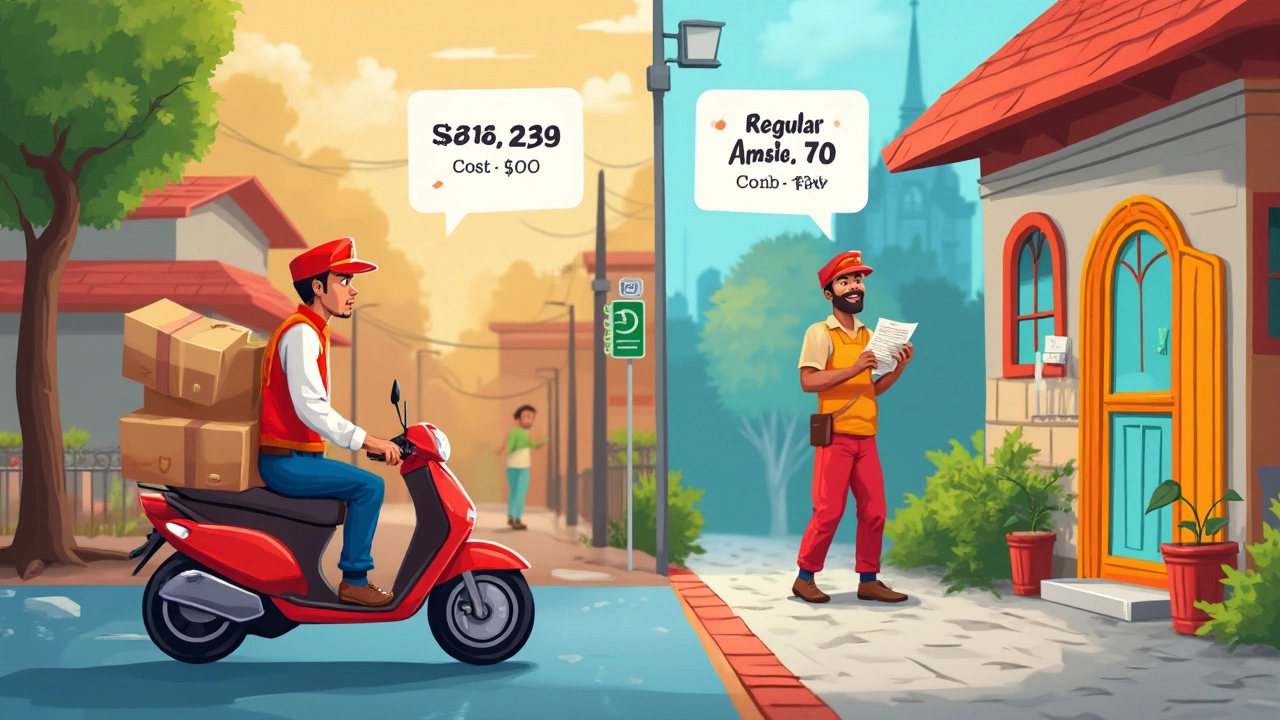Most people assume mailing a package through your local post office will always be easier on the wallet than booking a courier—but that's not always how it works out. It all comes down to what's inside your package, where it's headed, and how quickly you need it there. Miss these little details, and you might end up paying more than you have to.
For a small letter or something that can sit in a regular envelope, traditional mail almost always wins on price. But toss in a rush order, a heavy box, or an awkwardly shaped gadget, and suddenly, courier services sometimes sneak in as the better deal. It’s not just about the sticker price, either; you’ve got to think about tracking, insurance, and whether it gets there on time.
Most folks get caught by "hidden" charges. Need a signature when your parcel arrives? Want insurance for that collectible you’re sending? Those extras can quickly pile up, even with regular post. Couriers often include things like live tracking or basic coverage in their standard rate, so the comparison isn’t apples-to-apples.
Ready to see which option actually saves you cash? Let’s unpack what really matters when you’re choosing between mail and courier, toss in a few pro tips, and shine a light on the fees that most people don’t notice until their credit card bill arrives. Smart shipping starts right here.
- What Makes Up the Real Shipping Cost?
- When Is Mail Cheaper Than Courier?
- Surprising Cases Where Courier Wins
- Tips to Cut Your Shipping Costs
- What to Watch For: Extra Fees and Pitfalls
What Makes Up the Real Shipping Cost?
Shipping a package looks simple—slap on a label and send. But the price tag can make your head spin once you see the final bill. It's not just about the base rate. The total cost of sending something, whether you pick mail or courier cost, comes from several sneaky spots. Missing even one can turn a cheap shipment into an expensive lesson.
- Weight and Size: The heftier or bulkier the item, the more you’ll pay. Regular mail usually bumps up the price for anything over 500g, while couriers charge extra for weird shapes or stuff too big for a mailbox.
- Speed of Delivery: Standard mail rates climb if you need express service. Couriers often run overnight or same-day delivery, but speed always comes at a price.
- Distance and Zones: Sending a package across town costs less than shipping it cross-country or overseas. Both post offices and couriers use zones—further zones, fatter bill.
- Package Handling and Special Services: Need a signature on delivery or want package tracking? Mail and courier companies offer these, but not always for free. Often, they’re add-ons that sneak up on your final price.
- Insurance: Protecting pricey items adds a charge. Some couriers cover low-value items for free, but once you’re shipping something valuable, expect the insurance cost to jump.
- Fuel Surcharges and Remote Fees: Couriers sometimes tack on fuel or remote zone surcharges, especially if you’re sending to rural areas. The post office isn’t always off the hook either. Always check for these extras.
Let's check a side-by-side look at how the costs add up for regular mail versus a courier, based on a typical small package shipped from New York to Los Angeles:
| Service | Base Price | Example Delivery Time | Tracking Included | Signature Cost | Typical Total |
|---|---|---|---|---|---|
| USPS Priority Mail | $9.65 | 2-3 days | $0 (optional for basic) | $3.25 | $12.90 |
| FedEx Express Saver | $14.37 | 3 days | Included | Included | $14.37 |
That gives you a taste—sometimes mail is cheaper, sometimes a courier throws in extras that close the gap. Bottom line: the "real" cost is way more than just a website quote. Always check every add-on, and don't forget insurance or speed-up fees if you’re shipping anything important.
When Is Mail Cheaper Than Courier?
Sending stuff through regular mail usually makes the most sense when you're dealing with lightweight things, like letters, greeting cards, or official documents. If it fits in a standard envelope or even a small padded one, you won't beat the price of using the post office. In fact, for anything under 500 grams (about 1.1 lbs), the post almost always sneaks under courier prices, especially for domestic deliveries.
Mail wins by a mile when your package isn't time sensitive. Standard shipping can take a few extra days, but if speed isn't a big deal, you'll save cash. Here’s the sweet spot for mailing:
- Letters, postcards, and documents
- Small, non-urgent packages under 2kg (about 4.4 lbs)
- Flat, thin items that qualify as "letter mail"
- Nationwide shipping within the same country
Let’s look at some actual current costs as of June 2025:
| Service | Type | Weight Limit | Cost (Domestic) | Standard Delivery Time |
|---|---|---|---|---|
| Regular Mail | Letter | 30g (1 oz) | $0.95 | 2–5 business days |
| Regular Mail | Parcel | 1 kg (2.2 lbs) | $12.00 | 3–9 business days |
| Courier | Small Parcel | 1 kg (2.2 lbs) | $18.00–$25.00 | 1–2 business days |
Pay attention when sending internationally: for small documents, mail is still cheap. But if you start adding weight or need tracking and fast delivery, prices jump quickly, and you might as well look at couriers.
Another plus for regular mail? Most post offices have flat-rate options for small packages. You can mail a box, up to a certain weight, for a fixed fee—which often comes out cheaper than even the "economy" option from courier companies. In short, when you’re not in a hurry, your package is small, and you just want it to arrive safely without bells and whistles, standard mail keeps more money in your pocket.

Surprising Cases Where Courier Wins
It’s easy to think the standard post is always the low-cost champ, but there are real-life moments when couriers actually beat the regular mail on price and reliability. One big example: shipping something heavy across cities. If you’ve ever tried mailing a 10 kg package through your local post, you know the prices jump fast. Local couriers, on the other hand, sometimes offer flat rates for boxes up to 25 kg, especially within the same city. You might save a tenner or more if you just ask for a local courier quote before heading to the post office.
Another case—documents or products that just can’t get lost, like legal papers or expensive electronics. With regular mail, tracking or insurance are extra fees. But plenty of courier companies bake in door-to-door tracking and standard liability coverage with every job. If your item’s worth more than the postal insurance limit (which is surprisingly low in a lot of countries), a courier might be your only real choice.
And then there’s speed. Did you know that next-day delivery with a national post service often costs as much or even more than courier cost with the right local operator? Some couriers specialize in same-day or next-day runs without the postal delays or remote drop-off hassles. For online sellers and small businesses, that's a lifesaver—get it out, get it delivered, keep the customer happy, and don’t pay a premium for the speed.
Last thing: odd shapes or stuff outside the standard size. The post charges extra for anything that’s weirdly shaped (guitars, bulky car parts, you name it), but couriers often just price by distance and weight, not the size. If you’re moving something that doesn’t fit neatly into a normal box, always check local courier quotes before paying oversized fees at the post office.
Tips to Cut Your Shipping Costs
Shipping doesn’t have to empty your pockets if you know how to play it smart. Here are some practical moves you can make—not just vague advice.
- Compare before you commit: Rates can swing wildly between services, especially for heavier or odd-shaped packages. Try comparison sites like Shippo or Parcel Monkey—plug in your details and see the breakdown before buying a label.
- Go with flat-rate when it fits: USPS flat-rate boxes or similar options from other carriers can be a lifesaver for heavy stuff. If you’re shipping something dense for a long distance, you often save a chunk versus standard mail.
- Reuse packing materials: Even the box and stuffing add to your bill. Use what you already have at home, as long as it’s sturdy. Some couriers even charge for non-standard or oversized packaging, so keep it compact and close to the standard sizes.
- Drop-off saves cash: Some companies charge extra for door-to-door pickup. If you can drop your package at a courier shop or post office, you might save a couple bucks every time.
- Strip out unnecessary extras: Insuring an item or paying for tracking is smart only if you really need it. Skip the signature requirement unless it’s valuable or sensitive. Those small fees add up fast.
- Batch your shipments: Sending multiple parcels at once? Some couriers offer reduced rates or bulk deals. For businesses, this adds up over time.
Here’s a quick look at how these tips can translate into savings for a typical U.S. domestic box:
| Scenario | Standard Mail | Courier (Ground) |
|---|---|---|
| 3 lb package, local delivery | $8.70 | $9.15 |
| 3 lb package, cross-country (flat-rate used) | $17.60 | $13.25 |
| 3 lb package, insured & signed | $18.70 | $15.50 (tracking/insurance included) |
Notice how using a courier vs mail can flip costs on their head once insurance and tracking are included. The lesson? Always check the total price, not just the base rates. Bundling, dropping off, and being smart about packaging fees quickly add up to real savings.

What to Watch For: Extra Fees and Pitfalls
This is where people get tripped up. Even if you’re hunting for the lowest rate, little charges can add up fast. Whether you go with mail or a courier service, the base price is just the start. Here are some common extras you’ll want to look out for:
- Residential delivery fees — Some couriers tack on a charge just for dropping off a package at someone’s home instead of a business address.
- Remote area surcharges — Got a friend out in the sticks? Couriers love to upcharge for rural or hard-to-reach destinations.
- Fuel surcharges — Rates can change week-to-week depending on gas prices. That “cheap” courier deal might jump in cost overnight.
- Signature on delivery — Want proof your item got there? Canada Post adds around $2 to $3 for the service. Couriers often start at about $5 for the same perk.
- Insurance — Most base services only cover up to a certain amount. For expensive items, you’ll need to pay extra, usually 2% to 3% of the declared value.
- Oversized or awkward packaging — Got a box outside of standard measurements? Both Canada Post and most couriers will hit you with hefty extra fees, sometimes turning a $12 shipment into a $30 one.
To put the hidden costs into perspective, here’s a real-world snapshot comparing common add-ons between basic mail and courier:
| Service | Residential Fee | Signature Option | Basic Insurance Included | Rural Surcharge |
|---|---|---|---|---|
| Regular Mail (Canada Post) | $0 | $2.50 | Up to $100 | No extra |
| Courier (FedEx/Purolator) | $3-$5 | $5.00+ | Up to $100 | $10-$15 |
Here’s a solid tip: always use each company’s online shipping calculator before you send anything. The advertised price usually doesn’t show those add-ons until the last step. If you’re running a small business or shipping regularly, ask for a rate sheet or bulk discount—most carriers don’t advertise these until you ask.
That big courier vs mail decision? It really comes down to the fine print. Get smart about these extras, and you’ll keep your wallet a lot happier in the long run.





